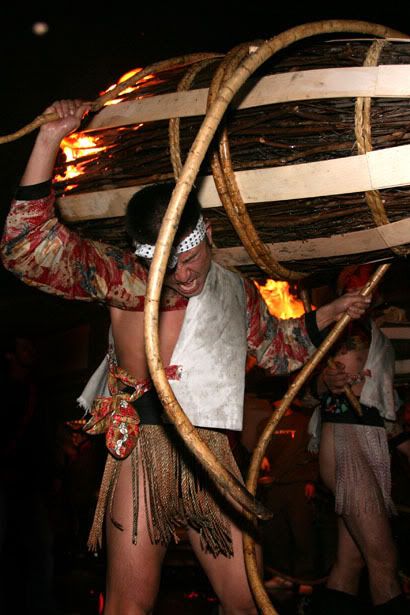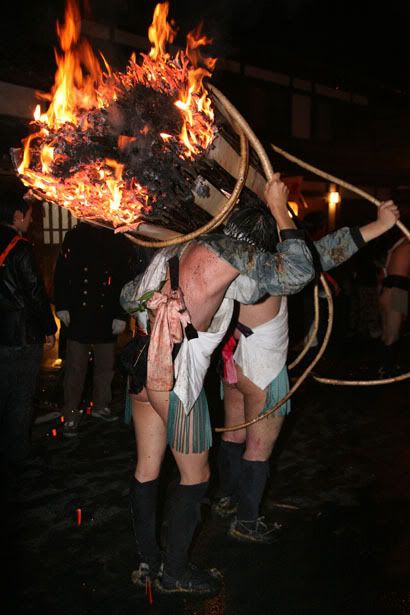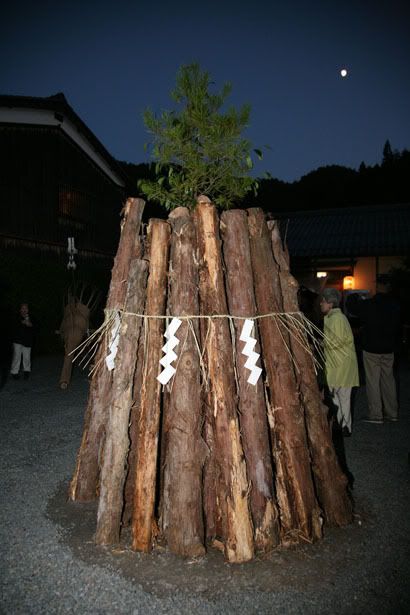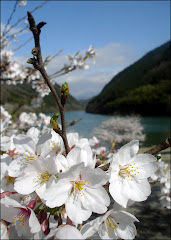One of Kyoto's biggest and most eccentric festivals, Kurama no Hi Matsuri captures the imagination, whisking the awe-struck spectator back in time through an ancient ritual preserved, protected and passed down through the ages to the progeny of an ancient Japan.
Nestled high in northern Kyoto's mountains, the rural town of Kurama consists of traditional, tiled-roof homes and shops crowded along a single main road, narrowly winding its way through the evergreen mountaintops that rise on either side. Each year, on October 22, as the moon begins to rise over these steely blue ridges and night casts its sleepy shadow over the usually quite town, a river of visitors from all over Japan flows from the small, provincial train station, flooding the town in a buzz of anticipation and excitement as they prepare to witness the rites and rituals of Kurama's famous Fire Festival. The Kyoto Shimbun Newspaper numbered the festival-goers in 2008 at over 10,200!

The ancient ritual is rooted in the troubles of the mid Heian Era, when the ancient capital was plagued by rebellion, great earthquakes and natural disasters. In 940, the emperor relocated Yuki Shrine from the grounds of the Imperial Palace north to Kurama in an attempt to appease the northern deities. Bonfires were lit along the road to Kurama, leading the procession of Shinto priests to the deity’s new home. Soon after, the plagues ceased and the rebellion was defeated, once again bringing peace to the empire. The spectacle of the great procession and miraculous virtue of the rites so impressed the people of Kurama that they determined to preserve them for posterity, each generation passing it on to the next.

Today the sacred Shinto rituals begin at 6 pm, but visitors begin arriving long before, seeking out the best places to experience the event and vying to get as close to the action as possible. By the time the sun disappears behind the hills, all open areas along the main road are filled with space-impaired spectators, corralled behind ropes and barriers to keep them a safe distance from the madness that will eventually ensue. Late-comers are ushered behind the early bird crowds by a seemingly infinite number of policemen, politely prodded to keep moving on a continual circuit from the train station, through the town, and back again, past homes and shops with torches of all sizes displayed proudly outside.

Suddenly a cry of "Shinji ni mairasshare!" echoes through the town. At the signal, the citizens of Kurama kindle the torches and small bonfires that line the main street, illuminating the way for the procession of fire.
A silver moon brightens the evening sky above a 3 meter mini-bonfire along the procession route, bound with a shimenawa. A shimenawa is a rope used to cordon off consecrated areas or to act as talisman against evil.
As night falls in high in the mountains, so do the temperatures. Festival-goers take time to warm up around the blazing bonfires, even as sparks and ash falls from the sky.
Tiny toddlers wrapped in brightly colored kimono carry hand held, bottle shaped torches as they are led up and down the main thoroughfare, walking hand in hand with their parents.

Next, small and medium sized torches are shouldered by elementary, junior high and high school boys. Finally, the five meter long taimatsu, or 'great torches', appear, shouldered by the town's young men. The Kurama taiko group, led by a feisty old woman artfully striking a great drum, leads the procession of taimatsu, accompanied by shouts of "Saireya Sairyo"!

A high school students shoulders the tail end of a 5 meter torch as sparks rain down behind him. Catching one of these falling sparks on your skin is said to be very auspicious, if not painful.
 These enormous torches weigh over 100 kilos, or 220 pounds.
These enormous torches weigh over 100 kilos, or 220 pounds.
 A group of scantily clad young men show off their "cute hips" in the revealing traditional festival gear.
A group of scantily clad young men show off their "cute hips" in the revealing traditional festival gear.


By 8 pm, over 250 torches are gathered on the great stone steps leading up to Kurama Temple. The heat of the blazing flames can be felt all along the roadside. The shimenawa is cut and the torches are consumed in a massive flame, painting the town in dancing vermillion light that flilckers against the deep, star speckled sky. Two omikoshi, or portable shrines, dance through the streets on the shoulders of Kurama's proud young men, bringing the festival to its climax.

The omikoshi and I with my new friends.
The last train out of Kurama leaves long before the festival draws to an end at midnight, and visitors line up for hours trying to catch one of the few trains back to civilization. My first visit to Kurama no Hi Matsuri was with my friends from Kansai Gaidai, one of whom happened to live a short walk from the festival's epicenter. Long after the tourists had gone, my friends and I drank sake and danced in the street with the townspeople. It is one of the most incredible experiences I've ever had, and for a moment, I felt as if I had experienced a very different Japan, Japan as it must have been long ago. That Japan still exists. You just have to know where to look for it.
You’ll find it in Kurama.
 Any Japanese festival is a great place to make new friends!
Any Japanese festival is a great place to make new friends!








4 comments:
Lol! Melissa, I have memories of that festival and the cramped trains back to civilization!! I've never experienced so much pushing from obasans before!!
And a happy un-birthday to you!
Question: Is that a tie or a belt?
nice time with cheeky boys ?
whoa, great pictures! it's crazy to think back to when we first went to the kurama fire festival...I'm glad you went back!
Post a Comment